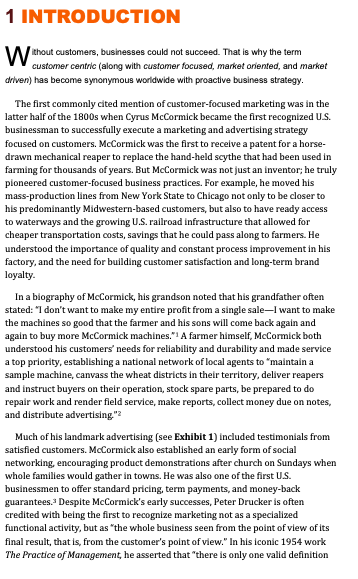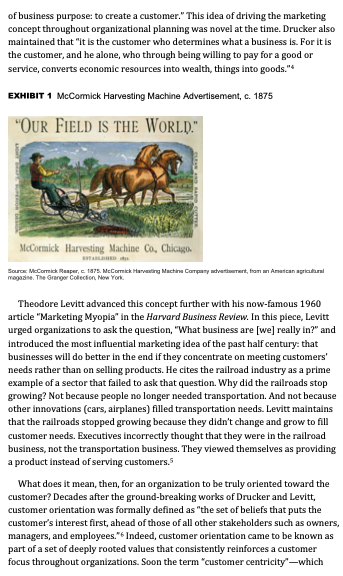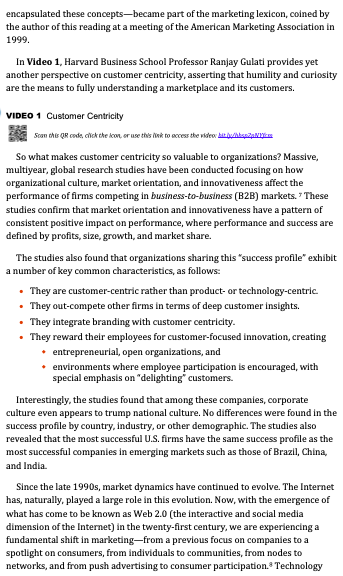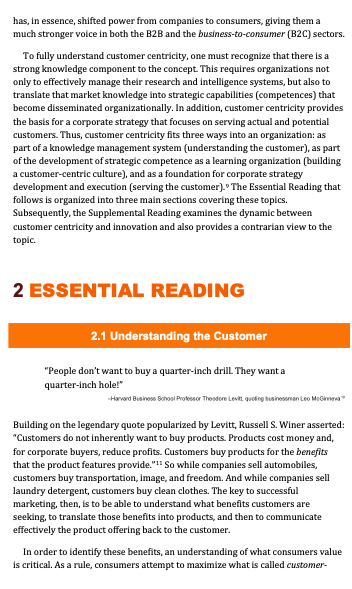- One of the most important elements of marketing is customer centricity. Refer to the reading "Customer Centricity." Please address these three issues in this question:
- Describe key customer-centric characteristics of successful companies
- Explain how technology has shifted power from companies to consumers and the implications for customer centricity.
- Identify factors that could prevent an older, established company from effecting an enterprise-wide, customer-centric culture.
1 INTRODUCTION W ithout customers, businesses could not succeed. That is why the term customer centric (along with customer focused, market onented, and market oviven) has become synonymous worldwide with proactive business strategy. The first commonly cited mention of customer-focused marketing was in the latter half of the 1800s when Cyrus Mccormick became the first recognized U.S. businessman to successfully execute a marketing and advertising strategy focused on customers. Mccormick was the first to receive a patent for a horse- drawn mechanical reaper to replace the hand-held scythe that had been used in farming for thousands of years. But Mccormick was not just an inventor; he truly pioneered customer-focused business practices. For example, he moved his mass-production lines from New York State to Chicago not only to be closer to his predominantly Midwestern-based customers, but also to have ready access to waterways and the growing U.S. railroad infrastructure that allowed for cheaper transportation costs, savings that he could pass along to farmers. He understood the importance of quality and constant process improvement in his factory, and the need for building customer satisfaction and long-term brand loyalty. In a biography of Mccormick, his grandson noted that his grandfather often stated: "I don't want to make my entire profit from a single sale-I want to make the machines so good that the farmer and his sons will come back again and again to buy more Mccormick machines." A farmer himself, Mccormick both understood his customers' needs for reliability and durability and made service a top priority, establishing a national network of local agents to *maintain a sample machine, canvass the wheat districts in their territory, deliver reapers and instruct buyers on their operation, stock spare parts, be prepared to do repair work and render field service, make reports, collect money due on notes, and distribute advertising."? Much of his landmark advertising (see Exhibit 1) included testimonials from satisfied customers. Mccormick also established an early form of social networking, encouraging product demonstrations after church on Sundays when whole families would gather in towns. He was also one of the first U.S. businessmen to offer standard pricing, term payments, and money-back guarantees." Despite Mccormick's early successes, Peter Drucker is often credited with being the first to recognize marketing not as a specialized functional activity, but as "the whole business seen from the point of view of its final result, that is, from the customer's point of view." In his iconic 1954 work The Practice of Management, he asserted that "there is only one valid definitionof business purpose: to create a customer." This idea of driving the marketing concept throughout organizational planning was novel at the time. Drucker also maintained that "It is the customer who determines what a business is. For it is the customer, and he alone, who through being willing to pay for a good or service, converts economic resources into wealth, things into goods."* EXHIBIT 1 Mccormick Harvesting Machine Advertisement, c. 1875 "OUR FIELD IS THE WORLD." Mccormick Harvesting Machine Co. Chicago. Source Mccormick Runpor, c. 1473. Mccormick Harwaiting Machin Company whatiwant, from in Arican agricultural magazine. The Grainger Collection, Now Work Theodore Levitt advanced this concept further with his now-famous 1960 article "Marketing Myopia" in the Harvard Business Review. In this piece, Levitt urged organizations to ask the question, "What business are [we] really in?" and introduced the most influential marketing idea of the past half century: that businesses will do better in the end if they concentrate on meeting customers' needs rather than on selling products. He cites the railroad industry as a prime example of a sector that failed to ask that question. Why did the railroads stop growing? Not because people no longer needed transportation. And not because other innovations (cars, airplanes] filled transportation needs. Levitt maintains that the railroads stopped growing because they didn't change and grow to fill customer needs. Executives incorrectly thought that they were in the railroad business, not the transportation business. They viewed themselves as providing a product instead of serving customers. What does it mean, then, for an organization to be truly oriented toward the customer? Decades after the ground-breaking works of Drucker and Levitt, customer orientation was formally defined as "the set of beliefs that puts the customer's interest first, ahead of those of all other stakeholders such as owners, managers, and employees." Indeed, customer orientation came to be known as part of a set of deeply rooted values that consistently reinforces a customer focus throughout organizations. Soon the term "customer centricity"-whichencapsulated these concepts-became part of the marketing lexicon, coined by the author of this reading at a meeting of the American Marketing Association in 1999. In Video 1, Harvard Business School Professor Ranjay Gulati provides yet another perspective on customer centricity, asserting that humility and curiosity are the means to fully understanding a marketplace and its customers. VIDEO 1 Customer Centricity Scan this QR code click the kon, or use this fisk to access the widew bit jibber3,Myjim So what makes customer centricity so valuable to organizations? Massive, multiyear, global research studies have been conducted focusing on how organizational culture, market orientation, and innovativeness affect the performance of firms competing in business-to-business (B28) markets. " These studies confirm that market orientation and innovativeness have a pattern of consistent positive impact on performance, where performance and success are defined by profits, size, growth, and market share. The studies also found that organizations sharing this "success profile" exhibit a number of key common characteristics, as follows: .They are customer-centric rather than product- or technology-centric . They out-compete other firms in terms of deep customer insights. . They integrate branding with customer centricity. . They reward their employees for customer-focused innovation, creating * entrepreneurial, open organizations, and * environments where employee participation is encouraged, with special emphasis on "delighting" customers. Interestingly, the studies found that among these companies, corporate culture even appears to trump national culture. No differences were found in the success profile by country, industry, or other demographic. The studies also revealed that the most successful U.S. firms have the same success profile as the most successful companies in emerging markets such as those of Brazil, China, and India. Since the late 1990s, market dynamics have continued to evolve. The Internet has, naturally, played a large role in this evolution. Now, with the emergence of what has come to be known as Web 2.0 (the interactive and social media dimension of the Internet) in the twenty-first century, we are experiencing a fundamental shift in marketing-from a previous focus on companies to a spotlight on consumers, from individuals to communities, from nodes to networks, and from push advertising to consumer participation.* Technologyhas, in essence, shifted power from companies to consumers, giving them a much stronger voice in both the B2B and the business-to-consumer (B2C) sectors. To fully understand customer centricity, one must recognize that there is a strong knowledge component to the concept. This requires organizations not only to effectively manage their research and intelligence systems, but also to translate that market knowledge into strategic capabilities (competences) that become disseminated organizationally. In addition, customer centricity provides the basis for a corporate strategy that focuses on serving actual and potential customers. Thus, customer centricity fits three ways into an organization: as part of a knowledge management system (understanding the customer), as part of the development of strategic competence as a learning organization (building a customer-centric culture), and as a foundation for corporate strategy development and execution (serving the customer].* The Essential Reading that follows is organized into three main sections covering these topics. Subsequently, the Supplemental Reading examines the dynamic between customer centricity and innovation and also provides a contrarian view to the topic. 2 ESSENTIAL READING 2.1 Understanding the Customer "People don't want to buy a quarter-inch drill They want a quarter-inch hole!" Harvard Business Schall Professor The Adore Levitt, quoting his howman Leo MeGinny * Building on the legendary quote popularized by Levitt, Russell S. Winer asserted: "Customers do not inherently want to buy products. Products cost money and, for corporate buyers, reduce profits. Customers buy products for the benefits that the product features provide."" So while companies sell automobiles, customers buy transportation, image, and freedom. And while companies sell laundry detergent, customers buy clean clothes. The key to successful marketing, then, is to be able to understand what benefits customers are seeking, to translate those benefits into products, and then to communicate effectively the product offering back to the customer. In order to identify these benefits, an understanding of what consumers value is critical. As a rule, consumers attempt to maximize what is called customer-perceived value (CPV), that is, they want the greatest benefit (economic, functional, psychological) from the lowest possible cost (evaluating obtaining. using, disposing) of the product or service (see Exhibit 2). This concept can also be captured by the equation: Value = Benefit - Cost and the simple explanation that a consumer will prefer a product or service offering a over offering b when: (Benefit, - Cost,) > (Benefit, - Cost.) or equivalently, Value, > Values EXHIBIT 2 Customer-Perceived Value CUSTOMER-PERCEIVED VALUE TOTAL CUSTOMER TOTAL BENEFIT CUSTOMER COST PRODUCT SERVICES PERSONAL IMAGE FIREFIT 0000 Souror Notker, Philip; Kallar, Kaving Murdering Marugement, 140, 0 2012. Pricked and Eladsonically produced by permission at Foron Education, Inc. Upper Bards River, New Jaiway Marketers can increase CPV by raising benefit offerings, lowering costs, or both. But it's important to remember that the overall benefit-to-cost ratio is what remains of value to customers, and that lowering costs at the expense of benefits could harm an organization's competitive advantage. Computer company Dell learned this lesson the hard way when it outsourced its customer











